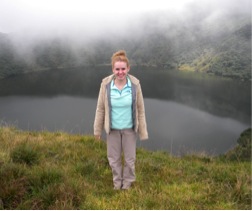Although I am just a ‘first year’ CASHP student, I spent my summer in the field with my advisor, Dr.Shannon McFarlin. We were based in Musanze, Rwanda, near Volcanoes National Park. We also made short trips to visit the Amboseli National Park in Kenya and Gombe National Park in Tanzania. These destinations may sound like stops on a luxury primate safari, but I assure you it was all in the name of science. Dr. McFarlin (CASHP) and her colleague, Dr. Tony Mudakikwa from the Rwanda Development Board’s Department of Tourism and Conservation, co-direct the collaborative Mountain Gorilla Skeletal Project*, and over the summer I joined the team’s efforts. A major goal of this project is to assist the Rwanda national parks authorities in the recovery and preservation of skeletal remains of recently deceased mountain gorillas (Gorilla beringei beringei), and to help build local capacity for their long-term curation and management as a resource for science and education in the country.

A full-bellied spotted hyena the morning after a feast, Amboseli National Park
You might be thinking, “Ok, so you’ve got Rwanda covered, but why did you need to go to Amboseli or Gombe?” Although there are in fact no mountain gorillas in southern Kenya or Tanzania, the collaboration has in recent years expanded to include the skeletal recovery and preservation of yellow baboons (Papio cynocephalus) from Amboseli and chimpanzees (Pan troglodytes schweinfurthii) and olive baboons (Papio anubis) from Gombe. So now you might be thinking, so what? So what if you have the skeletons? And what makes these collections any different from those in museums across the globe? First of all, you’ve got to trust me when I say that I wouldn’t have spent my summer in a termite-filled ditch, digging up massive gorilla skeletons with a spoon if this wasn’t a project I believe in. The research opportunities presented by these skeletal collections are unmatched; the skeletons we recover represent populations that have been the focus of long-term observational study for as long as 4-5 decades. That means researchers at these sites through their painstaking efforts have accumulated records on almost every individual that was born, lived, and died in their study groups. As a result of continuous monitoring of habituated animals from these study sites by primatologists, an enormous wealth of behavioral, health and climatic data are associated with their skeletons. This will allow researchers to answer questions that have never before been addressed regarding primate development, dietary ecology, and life history variation. Our current research on mountain gorillas includes investigating microanatomical defects in hard tissues (i.e., bones and teeth) that are understood to record incidence of stress experienced by individuals during their development. By comparing chronology of these markers in bones and teeth to associated behavioral and climate records, this can provide retrospective information about stress that complements knowledge gained from monitoring of these individuals in life. This research has implications for both evolutionary and conservation biology alike.

A chimpanzee enjoying a chunk of red colobus monkey, Gombe National Park, Tanzania
All of that being said, I think I had a pretty rad summer. I had planned to focus this entry on our more exhilarating moments in the field, like following chimps at Gombe (and seeing them eat two red colobus monkeys!), falling asleep (but really lying awake) to the sound of roaring lions and whooping hyenas just outside our canvas tents in Amboseli, or climbing (crawling) to the crater lake atop Mt. Visoke at 3700 meters in Rwanda. While there is no shortage of hair-raising adventures from this field season, I decided to take this opportunity to discuss our project and its significance. The really exciting part of the story is yet to come, from our research right here in D.C.
*Core collaborating partners in the Mountain Gorilla Skeletal Project include researchers from the Rwanda Development Board’s Department of Tourism and Conservation, Dian Fossey Gorilla Fund International, Mountain Gorilla Veterinary Project, Institute of National Museums of Rwanda, the George Washington University, and New York University College of Dentistry.
For more information, please visit the Amboseli Baboon Research Project and the Gombe Stream Research Center websites.


